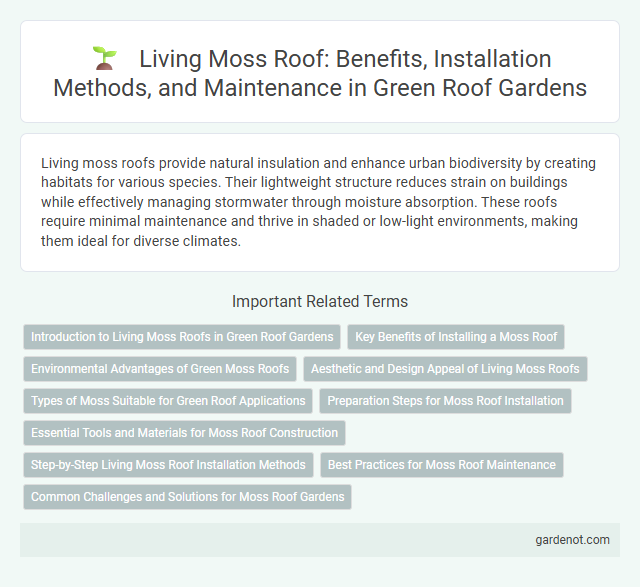Living moss roofs provide natural insulation and enhance urban biodiversity by creating habitats for various species. Their lightweight structure reduces strain on buildings while effectively managing stormwater through moisture absorption. These roofs require minimal maintenance and thrive in shaded or low-light environments, making them ideal for diverse climates.
Introduction to Living Moss Roofs in Green Roof Gardens
Living moss roofs are a sustainable green roof solution that enhances urban biodiversity while providing effective insulation and stormwater management. Composed primarily of dense, low-maintenance moss species, these roofs thrive in shaded, moist environments and require minimal soil depth compared to traditional green roofs. Their ability to retain water and reduce heat island effects makes living moss roofs an eco-friendly choice for modern green roof gardens.
Key Benefits of Installing a Moss Roof
Living moss roofs offer exceptional insulation properties, reducing energy costs by maintaining stable indoor temperatures. They enhance urban biodiversity by providing habitat for insects and birds, while improving air quality through natural filtration of pollutants. Moss roofs also require minimal maintenance and water, making them an eco-friendly and sustainable roofing option.
Environmental Advantages of Green Moss Roofs
Green moss roofs enhance urban biodiversity by providing habitats for various insects and birds while improving air quality through natural filtration of pollutants. These roofs significantly reduce stormwater runoff by absorbing and retaining rainfall, lessening the burden on drainage systems and minimizing flood risks. The insulating properties of green moss roofs contribute to energy savings by maintaining building temperature stability, lowering heating and cooling demands.
Aesthetic and Design Appeal of Living Moss Roofs
Living moss roofs enhance architectural aesthetics by adding vibrant, natural textures and a lush green appearance that evolves seasonally. Their design appeal lies in seamless integration with urban and rural landscapes, creating visually striking, eco-friendly surfaces that soften building lines. These roofs support diverse moss species, offering varied color palettes and patterns, making each installation a unique living artwork.
Types of Moss Suitable for Green Roof Applications
Suitable moss species for living moss roofs include Bryum, Hypnum, and Sphagnum, known for their resilience and moisture retention capabilities. Bryum moss thrives in sun-exposed areas, while Hypnum adapts well to shaded environments, making both ideal for varying green roof microclimates. Sphagnum moss, often used for its exceptional water-holding capacity, enhances insulation and supports biodiversity on green roof installations.
Preparation Steps for Moss Roof Installation
Preparation for living moss roof installation begins with selecting a suitable substrate that retains moisture while providing adequate drainage, such as a lightweight soil mix or specialized growing medium. The surface must be thoroughly cleaned and leveled to ensure proper moss adhesion and growth, removing debris and smoothing uneven areas. Pre-soaking moss fragments or mats in water enhances hydration, promoting faster establishment and a healthy, thriving moss roof.
Essential Tools and Materials for Moss Roof Construction
Essential tools for living moss roof construction include a trowel, spray bottle, garden scissors, and a stiff brush to prepare and maintain the moss layer. Key materials involve nutrient-rich substrate, a moisture-retentive growing medium such as coconut coir or peat moss, and selected moss species adapted to local climate conditions. Waterproof membrane and drainage layers are critical to ensure roof integrity and prevent water damage while supporting moss growth.
Step-by-Step Living Moss Roof Installation Methods
Living moss roof installation begins with selecting a suitable substrate, typically a lightweight, moisture-retentive growing medium that supports moss growth while ensuring proper drainage. Next, moss fragments or mats are carefully placed and pressed onto a pre-moistened substrate surface to encourage rooting and establishment. Regular watering and shading during the initial weeks promote moss acclimatization and healthy coverage, resulting in a resilient and low-maintenance green roof system.
Best Practices for Moss Roof Maintenance
Living moss roofs require consistent moisture levels and indirect sunlight to thrive, making regular misting and shading essential for optimal growth. Removing debris and ensuring proper drainage prevents moss decay and structural damage, preserving the roof's health and longevity. Periodic inspections for pests and invasive plants help maintain the moss ecosystem's balance, ensuring sustainable green roof performance.
Common Challenges and Solutions for Moss Roof Gardens
Moss roofs often face challenges such as moisture retention leading to potential water damage, limited nutrient availability, and vulnerability to pests. Solutions include using moisture-retentive but well-draining substrates, selecting moss species adapted to the local climate, and implementing integrated pest management strategies. Regular maintenance involving gentle cleaning and monitoring helps sustain moss health and prevents overgrowth or decay.
Living moss roof Infographic

 gardenot.com
gardenot.com